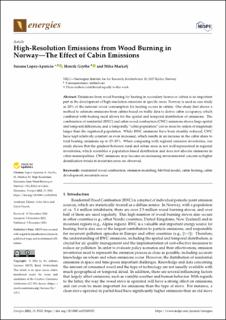| dc.contributor.author | Lopez-Aparicio, Susana | |
| dc.contributor.author | Grythe, Henrik | |
| dc.contributor.author | Markelj, Miha | |
| dc.date.accessioned | 2022-12-13T10:05:13Z | |
| dc.date.available | 2022-12-13T10:05:13Z | |
| dc.date.created | 2022-12-09T13:51:58Z | |
| dc.date.issued | 2022 | |
| dc.identifier.citation | Energies. 2022, 15, 9332. | en_US |
| dc.identifier.issn | 1996-1073 | |
| dc.identifier.uri | https://hdl.handle.net/11250/3037436 | |
| dc.description.abstract | Emissions from wood burning for heating in secondary homes or cabins is an important part in the development of high-resolution emissions in specific areas. Norway is used as case study as 20% of the national wood consumption for heating occurs in cabins. Our study first shows a method to estimate emissions from cabins based on traffic data to derive cabin occupancy, which combined with heating need allows for the spatial and temporal distribution of emissions. The combination of residential (RWC) and cabin wood combustion (CWC) emissions shows large spatial and temporal differences, and a temporally “cabin population” can in areas be orders of magnitude larger than the registered population. While RWC emissions have been steadily reduced, CWC have kept relatively constant or even increased, which results in an increase in the cabin share to total heating emissions up to 25–35%. When comparing with regional emission inventories, our study shows that the gradient between rural and urban areas is not well-represented in regional inventories, which resembles a population-based distribution and does not allocate emissions in cabin municipalities. CWC emissions may become an increasing environmental concern as higher densification trends in mountain areas are observed. | en_US |
| dc.language.iso | eng | en_US |
| dc.rights | Navngivelse 4.0 Internasjonal | * |
| dc.rights.uri | http://creativecommons.org/licenses/by/4.0/deed.no | * |
| dc.title | High-Resolution Emissions from Wood Burning in Norway—The Effect of Cabin Emissions | en_US |
| dc.title.alternative | High-Resolution Emissions from Wood Burning in Norway—The Effect of Cabin Emissions | en_US |
| dc.type | Peer reviewed | en_US |
| dc.type | Journal article | en_US |
| dc.description.version | publishedVersion | en_US |
| dc.rights.holder | © 2022 by the authors. Licensee MDPI, Basel, Switzerland. | en_US |
| dc.source.volume | 15 | en_US |
| dc.source.journal | Energies | en_US |
| dc.identifier.doi | 10.3390/en15249332 | |
| dc.identifier.cristin | 2091274 | |
| dc.relation.project | NILU - Norsk institutt for luftforskning: 120011 | en_US |
| dc.relation.project | Norges forskningsråd: 247884 | en_US |
| dc.relation.project | Miljødirektoratet: 2017/8676 | en_US |
| dc.relation.project | Miljødirektoratet: 20087252 | en_US |
| dc.relation.project | NILU - Norsk institutt for luftforskning: 116060 | en_US |
| dc.source.articlenumber | 9332 | en_US |
| cristin.ispublished | true | |
| cristin.fulltext | original | |
| cristin.qualitycode | 1 | |

